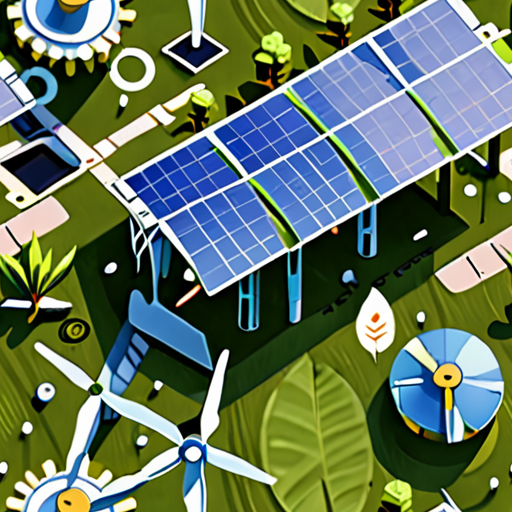As the world grapples with the challenges of climate change, environmental degradation, and social inequality, the need for sustainable technology development has never been more pressing. This innovative approach to technological advancement seeks to balance economic growth with environmental stewardship and social responsibility, creating a framework for harmonious growth and technological progress. By harnessing the power of technology to drive sustainable development, we can unlock new opportunities for economic prosperity, improve the quality of life for communities around the world, and mitigate the negative impacts of human activity on the environment.

What is Sustainable Technology Development?
Sustainable technology development refers to the integration of environmental responsibility, social equity, and economic viability into the design, implementation, and operation of technological systems.
- It involves a combination of strategies and practices aimed at reducing energy consumption, minimizing waste, and promoting environmentally responsible decision-making within the IT industry.
- This approach considers the long-term consequences of technological innovations and seeks to minimize their negative impacts on the environment and society.
Key Principles of Sustainable Technology Development:
- Environmental Stewardship: Minimizing the ecological footprint of technological systems through efficient resource use, reduced emissions, and waste reduction.
- Social Responsibility: Ensuring that technological innovations benefit society as a whole, promote social justice, and respect human rights.
- Economic Viability: Developing technologies that are economically viable, scalable, and accessible to all stakeholders, while generating revenue and creating jobs.
Benefits of Sustainable Technology Development:
- Reduced Environmental Impact: Lower greenhouse gas emissions, reduced e-waste, and minimized pollution.
- Improved Social Outcomes: Enhanced social equity, better health outcomes, and increased access to education and employment opportunities.
- Increased Economic Efficiency: Reduced costs, improved productivity, and increased competitiveness.
Examples of Sustainable Technology Development:
- Clean Energy Technologies: Solar panels, wind turbines, and hydrogen fuel cells that reduce dependence on fossil fuels.
- Energy-Efficient Buildings: Green buildings that minimize energy consumption and maximize natural light and ventilation.
- Smart Grids: Advanced grid management systems that optimize energy distribution and consumption.
Challenges and Opportunities:
- Technological Limitations: Current technological limitations hinder the widespread adoption of sustainable technologies.
- Policy and Regulatory Frameworks: Inadequate policies and regulations can hinder the development and deployment of sustainable technologies.
- Public Awareness and Education: Raising public awareness and education about the benefits and importance of sustainable technology development.
The 5 Cs of Sustainable Development
As we strive for a more sustainable future, understanding the core principles of sustainable development is crucial.
- Clean
- Implementing renewable energy sources, such as solar and wind power, can significantly reduce our carbon footprint.
- Reducing, reusing, and recycling materials can minimize waste and conserve natural resources.
- Community
- Social cohesion and community engagement can lead to better decision-making and more effective resource allocation.
- Involving local stakeholders in planning and implementation processes ensures that projects meet community needs and values.
- Culture
- Respecting and preserving cultural heritage can foster a sense of identity and belonging among community members.
- Culturally sensitive approaches to development can promote social equity and reduce conflict.
- Care
- Investing in healthcare infrastructure and services can improve overall well-being and reduce poverty.
- Addressing mental health concerns and promoting work-life balance can enhance productivity and job satisfaction.
- Corporate Governance
- Transparency and accountability in business operations can prevent corruption and ensure fair labor practices.
- Stakeholder engagement and responsible investment decisions can promote long-term sustainability and profitability.
Emphasizing environmental stewardship, clean encompasses reducing waste, conserving resources, and promoting eco-friendly practices.
Fostering strong, inclusive communities is vital for sustainable development.
Cultural sensitivity and awareness are essential for successful sustainable development initiatives.
Prioritizing human well-being and health is critical for sustainable development.
Effective corporate governance is necessary for responsible business practices and sustainable development.

What is Sustainability in Tech?
Sustainability in tech refers to the integration of environmentally friendly and socially responsible practices into the design, development, and deployment of technological products and services.
- Reducing electronic waste through recyclable materials and energy-efficient designs
- Implementing renewable energy sources to power data centers and operations
- Developing software and applications that promote sustainable behaviors and habits
- Fostering inclusive and diverse workplaces to drive innovative solutions
Key Principles of Sustainable Technology
The core principles of sustainable technology include:
- Environmental stewardship: minimizing harm to the environment and promoting eco-friendly practices
- Social responsibility: prioritizing human well-being and promoting equitable access to technology
- Economic viability: ensuring that sustainable technologies are economically feasible and scalable
Benefits of Sustainable Technology
The adoption of sustainable technology can bring numerous benefits, including:
- Reduced carbon footprint and greenhouse gas emissions
- Improved resource efficiency and reduced waste
- Increased competitiveness and market share
- Enhanced reputation and brand loyalty
Examples of Sustainable Technologies
Some notable examples of sustainable technologies include:
- Renewable energy systems, such as solar and wind power
- Energy-efficient data centers and cloud computing platforms
- Sustainable materials and manufacturing processes
- Artificial intelligence and machine learning applications for predictive maintenance and energy optimization
Future Directions for Sustainable Technology
As technology continues to evolve, we can expect to see further innovations in sustainable technologies, including:
- Advances in renewable energy storage and grid management
- Development of circular economy business models and closed-loop production systems
- Integration of artificial intelligence and IoT sensors for real-time monitoring and optimization
- Increased focus on digital literacy and education for sustainable development

Sustainable Development Examples
We’re committed to empowering our audience with knowledge on innovative solutions and technologies.
- Renewable Energy
- Investing in solar and wind power can provide clean energy and create jobs in the renewable energy sector.
- Implementing energy-efficient technologies and practices can reduce energy consumption and lower greenhouse gas emissions.
- Sustainable Agriculture
- Organic farming methods can reduce the use of synthetic fertilizers and pesticides, promoting healthier ecosystems and reducing environmental pollution.
- Agroforestry systems can integrate trees into agricultural landscapes, providing shade, improving soil fertility, and supporting wildlife habitats.
- Circular Economy
- Designing products for recyclability, reusability, and biodegradability can minimize waste and reduce the need for raw materials.
- Sharing platforms and product-as-a-service models can encourage sharing, leasing, and product reuse, reducing ownership and waste.
- Green Infrastructure
- Green roofs can insulate buildings, reduce stormwater runoff, and provide habitat for urban wildlife.
- Urban forestry initiatives can enhance air quality, mitigate the urban heat island effect, and provide recreational spaces for communities.
One example of sustainable development is the shift towards renewable energy sources, which can significantly reduce our reliance on fossil fuels and mitigate climate change.
Sustainable agriculture practices, such as permaculture and regenerative agriculture, can promote soil health, conserve water, and support biodiversity.
A circular economy approach aims to reduce waste and the continuous consumption of resources by designing products and systems that are restorative and regenerative by design.
Green infrastructure, such as green roofs, urban forests, and green spaces, can provide ecosystem services, mitigate the urban heat island effect, and improve air quality.
The 4 Cs of Sustainability
Sustainability is a multifaceted concept that encompasses various aspects of human activity, from environmental conservation to social responsibility.
- Conservation: This aspect focuses on preserving natural resources, protecting biodiversity, and mitigating the impact of human activities on the environment.
- Community: Community involvement is crucial in promoting sustainability, as it ensures that local needs and concerns are addressed, and that stakeholders are engaged in decision-making processes.
- Culture: Cultural sensitivity and awareness play a vital role in sustainability efforts, as they help to promote understanding, respect, and cooperation among diverse groups.
- Commerce: Sustainable commerce involves adopting environmentally friendly practices, reducing waste, and promoting eco-friendly products and services.
By balancing these four components, we can create a more sustainable future that benefits both people and the planet.
Key Principles of the 4 Cs
- Interconnectedness: Recognize the interconnectedness of economic, social, and environmental systems and strive to balance them.
- Long-term thinking: Adopt a long-term perspective when making decisions, considering the potential consequences of actions on future generations.
- Stakeholder engagement: Engage with diverse stakeholders, including local communities, businesses, and governments, to ensure that their needs and concerns are addressed.
- Innovation and collaboration: Foster innovation and collaboration among stakeholders to develop and implement effective sustainability solutions.
Real-world Applications of the 4 Cs
The 4 Cs of sustainability have been applied in various contexts, including:
- Corporate sustainability initiatives: Companies like Patagonia and REI have implemented sustainable practices, such as using recycled materials and reducing energy consumption.
- Community-led projects: Local communities have developed innovative solutions, such as community gardens and renewable energy cooperatives, to promote sustainability.
- Government policies: Governments have established regulations and incentives to encourage sustainable practices, such as carbon pricing and green infrastructure investments.
By embracing the 4 Cs of sustainability, we can create a more resilient, equitable, and environmentally conscious world.

The 5 Ps of Sustainable Development Explained
The 5 Ps of sustainable development are a crucial framework for understanding the interconnectedness of the United Nations’ 17 Sustainable Development Goals (SDGs). These five pillars – People, Planet, Prosperity, Peace, and Partnerships – work together to create a balanced and harmonious approach to achieving global sustainability.
-
People
The People pillar focuses on ensuring that all individuals have access to basic human rights, education, healthcare, and social protection. This includes promoting gender equality, reducing poverty, and improving living standards.
-
Planet
The Planet pillar emphasizes the need to protect the environment and preserve natural resources for future generations. This involves addressing climate change, conserving biodiversity, and promoting sustainable agriculture and energy practices.
-
Prosperity
The Prosperity pillar aims to promote economic growth and development while ensuring that benefits are shared equitably among all segments of society. This includes investing in infrastructure, promoting entrepreneurship, and fostering international cooperation.
-
Peace
The Peace pillar seeks to promote peaceful and inclusive societies by addressing conflict, violence, and inequality. This involves promoting disarmament, demobilization, and reintegration, as well as supporting post-conflict reconstruction and development.
-
Partnerships
The Partnerships pillar recognizes the importance of collaboration and cooperation among governments, civil society, the private sector, and other stakeholders to achieve the SDGs. This involves building partnerships, mobilizing resources, and leveraging expertise to drive progress towards sustainable development.
In conclusion, the 5 Ps of sustainable development offer a comprehensive framework for understanding the complex relationships between people, planet, prosperity, peace, and partnerships. By working together to address these interconnected challenges, we can create a more just, equitable, and sustainable world for all.

0 Comments